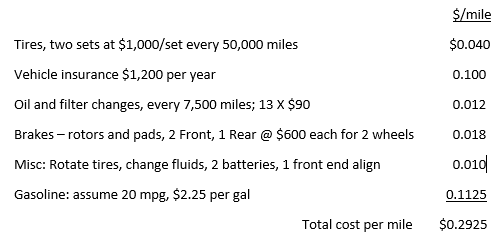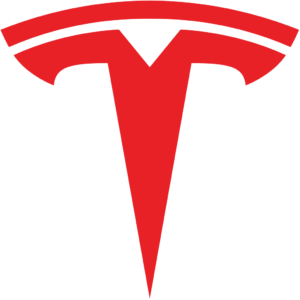Future Vehicle Ownership Options:
It is a foregone conclusion that for economic reasons alone battery-powered electric vehicles will replace conventional ICE-powered vehicles within the next 5 to 10 years. This change also provides the additional benefit of helping to ameliorate our current environmental problems as ICE-created smog will increasingly vanish. One of the current COVID-19 pandemic’s primary benefits (and maybe the only one) has been to dramatically illustrate the pollution effects of ICE-powered vehicles by the emergence of much clearer skies over cities where vehicle traffic was shut down to a bare minimum.
Given that EV’s are coming on a massive scale, the prospective vehicle owner is left with four basic choices:
- Pay off and keep driving their ICE-powered vehicle until it drops
- Buy or lease an EV and drive it only for personal use
- Buy or lease an EV and mix its use between personal and limited “business” use
- Buy or lease one or more EVs and establish a Robotaxi TaaS fleet business.
Option 1: Pay off and keep driving an ICE-powered vehicle until it drops:
Even if your ICE-powered vehicle is fully paid off, the cost of fuel, maintenance, insurance, inspections and licensing, and the like will continue to cost between roughly $0.30 to $0.35 per mile, increasing steadily as miles accrue until finally the vehicle becomes uneconomical to sink any more money into.
Examining operating costs per mile for 100,000 miles, driving 12,000 miles per year for 8.3 years:

NB: If gasoline averages $3.00 a gal, total cost increases by $0.0375 to $0.33 a mile.
Furthermore, observe that the above costs do not include any costs for major repairs to items such as an A/C compressor, automatic transmission or standard clutch, water pump, fuel injectors or fuel pump, etc.. A total of $4,000 of these repairs over 100,000 miles would add another $0.04 per mile to the above costs.
As noted earlier, most ICE-powered vehicles that are well maintained could have a life of about 150,000 to 200,000 miles. For the average driver at 12,000 miles per year this would indicate a vehicle life of 12.5 to 16.7 years. Note that attaining this life is beyond the average user’s experience as the average years on the road before scrappage for cars and pickup trucks is about 13 years.
Option 2: Buy or lease a battery-powered electric vehicle only for personal use:
Many studies today show the all-in cost of owning and driving an electric vehicle ranges from about $0.30 a mile to $0.80 a mile. In these analyses, the complications of measuring fuel prices and consumption for an ICE-powered vehicle are similar to that of calculating the average cost of electricity to charge an EV. Here, the cost to charge your vehicle’s battery can be zero if you either own a Tesla Model S or X (free lifetime Tesla Supercharger use^^), or if you have a solar roof that charges your vehicle and house. Indeed, in some situations you can make money supplying electric power back to your local electricity grid. ^^[ On May 27, 2020 Tesla announced that buyers of its Models S and X would no longer receive free lifetime Supercharger use. Now all Tesla owners have to pay the rates listed below.]
When you do have to pay for charging, the prices can vary significantly, depending on whether you are using home electricity at a US average of about $0.13 a kWh, or whether you are charging at a Tesla Supercharger station where the cost is usually $0.28 a kWh*, or whether you are charging at another brand’s charging station where you not only might have to pay a higher rate by the kWh, but also in addition pay by the minute for your charging time. *[On approximately May 12, 2020 Tesla started billing time-dependent charging time rates at at least some of its Supercharger stations. 12AM to 4PM is $0.29 per kWh, 4PM to 9PM is $0.35 per kWh, and 9PM to 12AM is $0.29 per kWh. Idle fees – the time you leave your vehicle connected to the charger after its battery is fully charged will cost an additional up to $1.00 per minute.]
These charging prices and costs will only continue to decrease in the future for three reasons:
- Electrical power will continue to get less expensive
- Increased competition will force charging station operators to lower their prices
- Electric vehicle batteries will be more powerful with greater range and shorter charging times, thereby lowering the cost of charging an electric vehicle’s battery over its lifetime.
The largest cost factor for many EVs is their initial purchase price. Obviously, it costs more to buy an Audi e-tron than it does a Nissan Leaf.
Option 3: Buy or lease an EV and mix its use between personal and limited “business” use:
One of the opportunities for anyone owning an electric vehicle capable of autonomous driving is to put that asset to work earning you money. After all, it’s just sitting around 95% of the time, right? However, if it going to work you either as a formal business or as a “side hustle” you will need to find a booking service to work with that has a software platform and a laptop/cellphone “app” that people can use to book and pay for their rides. Obviously, you will pay a fee for this service.
In addition, at least if you have a Tesla, you may want to set up boundaries for your vehicle’s use. This may involve the use of geofencing where the user cannot take your vehicle outside of a 40-mile radius of your community, for instance. Other such boundaries may include setting limits on the use of Autopilot or limiting your vehicle’s top speed or even how fast it can accelerate, whether the user has full use of your vehicle’s entertainment options, and the like. All these limits are software programable via the Tesla’s vehicle management software and/or your cellphone.
Consider the following scenario. You hop into your autonomous EV in the morning and it drops you off at work. It then joins a Robotaxi arrangement where it works for you earning money throughout the day. At the end of your workday, your car picks you up and takes you home, perhaps running some errands on the way home. Assume that your work commute is 45 minutes each way. So without your vehicle being in the Robotaxi business, it is only used by you 1.5 hours per day, and sits idle either in a workplace parking spot or at home most of the time – except for what is likely less than three hours of driving on a weekend. Assume in the eight hours you are at work your working Robotaxi can obtain four hours of chargeable “work” time on your behalf. Suddenly, its utilization has increased from 6.3% to 22.9%. That’s better, but more utilization and asset earning power from your autonomous vehicle is possible.
Another possible scenario is that you could have your autonomous EV work just weekends for you, maybe Friday nights from 6 PM until Sunday nights at 6 PM. Assume out of that 48 hours your vehicle could spend 40% of its time (or 19.2 hours) working for you – driving a paying customer. By raising your car’s utilization from 4.5% (driving you only to work and back), its total utilization is now 15.9%, 3.5 times better. Even at an urban average of 30 mph, that’s 576 miles a weekend of money earning potential, at a potential rate currently ranging from $1.00 to $3.00 a mile, depending on your vehicle. More details later.
Photo courtesy of Pixabay
Your feedback in the form of comments or suggestions are welcome in the comment window. Thank you for following my blogs on this site and for participating in my blogging community.




